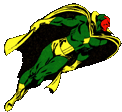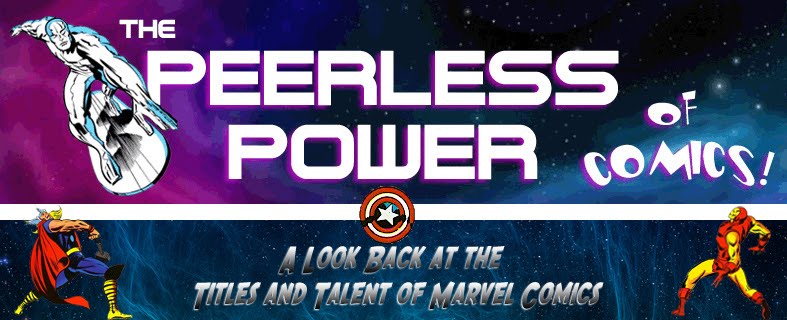The prelude to the classic Avengers/Defenders war took place in the September 1973 stories of each title, kicked off in separate epilogues following their main stories. In sequence, the first to read would have to be the epilogue of Avengers #115, which segued to its follow-up in Defenders #8--both of which can be sampled in a separate post. The two segments are driven by the common denominator of the Black Knight--his mysterious disappearance and his fate, respectively--but the main Avengers tale gets short-changed a bit, since what the team discovers at the site of Garrett Castle is a separate encounter that must play out before they move on to address the mystery of the Knight, and that story as a result is given limited space to pique the reader's interest.
 On the other hand, the foe the Avengers face is not a powerful one nor a particularly formidable one, considering that the lineup of the Avengers at this point in time is unquestionably both--and so the story doesn't necessarily require a great deal of space to be resolved. (In fact, all things considered, it may be using too much space to dispatch the opposition.) But with other elements in the story taking up the Avengers' time, there are only eleven pages to dedicate to the main conflict--roughly the same amount of pages that stories in Tales Of Suspense, Tales To Astonish, or Strange Tales had available for splitting their issues between two heroes in separate stories.
On the other hand, the foe the Avengers face is not a powerful one nor a particularly formidable one, considering that the lineup of the Avengers at this point in time is unquestionably both--and so the story doesn't necessarily require a great deal of space to be resolved. (In fact, all things considered, it may be using too much space to dispatch the opposition.) But with other elements in the story taking up the Avengers' time, there are only eleven pages to dedicate to the main conflict--roughly the same amount of pages that stories in Tales Of Suspense, Tales To Astonish, or Strange Tales had available for splitting their issues between two heroes in separate stories.Yet, even wedged in as it is, "Below Us The Battle!" doesn't fall into the category of a throw-away story, and it certainly isn't filler material. Yes, the Avengers probably have more trouble with their foes than might be reasonable to expect for "Earth's mightiest heroes"--and yes, it's confusing to see the Avengers so at a loss to handle superior numbers, given how they met and vanquished a mass of armed warriors far more adept at savage combat and with far greater armament than the primitive foes they face here. But the circumstances of the encounter are intriguing enough to leave you at least satisfied, while the bookends of the Defenders plot are sufficiently distracting to supplement any perceived weaknesses in the main story.
There's also the added benefit that writer Steve Englehart is finding his legs with the Avengers, and so there's no shortage of continuing character development. In this case, the Swordsman, their newest member, finds that he's persona non grata in the U.K. when the Avengers quinjet, on its way to the Black Knight's ancestral castle, is boarded by a S.H.I.E.L.D. craft that's been dispatched to deliver a brief but blunt message for the team:
(Does this SHIELD agent think he's landing on the moon?)
No, I don't know many people who equate reform with holiness of the reformer, either, but let's give this guy the benefit of the doubt and assume his space suit isn't supplying enough oxygen to his helmet; either that, or the comment made perfect sense to Englehart for some undisclosed reason. Regardless, the agent is quite civil with the Avengers (his gangbuster entrance aside) and allows them to proceed, though with a strong admonition to make their visit a brief one.
Landing at Garrett Castle, though, the team literally runs up against the mystery of the Knight's disappearance, when the barrier placed on the castle by Dr. Strange from a prior Defenders story stops them in their tracks. But we should keep in mind that Strange has neglected to inform the Avengers of his actions, much less the current predicament of the Knight--so this development can only arouse their concern.
Efforts by the various team members to breach the barrier fail. It's only when the Scarlet Witch makes her own attempt that they're able to discern a clue as to its origin and make headway in identifying the source, thanks to the "empathy with nature, a sensitivity to vibrations, order, and disorder" of Mantis--which, by any other name, would be clairvoyance.
Before the Avengers can investigate further, a company of troglodytes appears from hidden access points beneath the ground and swarms over the team, attacking without warning or apparent reason. Their first wave quickly takes out Wanda and the Panther; and while the Avengers regroup, the Swordsman and Mantis are the next to fall. That leaves the "big three" (Captain America, Iron Man, and Thor) along with the Vision, all of whom fall far more quickly than you might expect, victims of subterranean gas.
All the Avengers are bound and taken below the surface--and from Skol, the "king" of these people, we learn that these troglodytes have been living and procreating in the caves beneath the Knight's estate for 300 years. You'll also notice that Skol's limited speech pattern is significantly less eloquent than that of his counterpart on this issue's cover.
We've seen that these people were persecuted in the middle ages, and forced to seek refuge within tunnels and make new lives for themselves there in safety. We can only assume that they felt the danger to them was ever-present, and rarely if ever ventured topside to keep up on current events (or, in what would seem to be a priority, to make runs for food and supplies); as a result, and limited to inbreeding, their intelligence eventually waned, and they became as we see them today, regularly stealing food from Garrett Castle until Strange's spell prevented further access.
It's the action that blocked their way that has angered them to the point of taking the Avengers captive, so it's reasonable to assume that they came to heavily depend on the food within the castle--which means that Dane Whitman either entertained a lot, or for some reason kept a great deal of food on hand for himself. It's difficult to *ahem* swallow either theory, but it would be crucial to establishing the motivation for the troglodytes' attack on the Avengers.
As for the Avengers themselves, they don't get far with their denials before Skol, whose reason has long since fled him as it has his people, orders the team hurled into a dark pit where waits a gigantic, blind insect-creature with sharp pincers that have a clear purpose. It's the first we learn that the gas that felled the team also weakened their will to resist (a revelation very conveniently timed, considering they could have avoided ending up in the pit otherwise), and so those who can free themselves (Thor, the Vision, and Mantis) do so--and before the creature can injure the others, Mantis strikes the killing blow.
At that point, Skol and the others take the direct approach, and douse the torch in the pit so that they can descend through a tunnel and take the Avengers by surprise in near-total darkness. Only the Panther can hope to fend them off, since his eyes can quickly adjust to the lack of light--and so he takes the point, his resistance sufficiently harsh to convince the other troglodytes that they fight a losing battle. But in losing, they gain the help that they need to come out of the darkness for good.
It's really not a bad idea for a tale, though it reads rather condensed under the circumstances and thus loses some of the impact it might have had. I wouldn't have wanted to see it expanded to two issues--but it would have been interesting to learn more of the trials of these people as they steadily resigned themselves to stay clear of the surface and their ability to hold onto their intelligence slowly slipped away. It also seems unusual for poachers to be persecuted to such an extent and killed on sight, while having to avoid constant patrols. It's always been my impression that those who ruled in the middle ages had more important uses for their forces than to patrol the lands for those looking for food in a concentrated effort to wipe them out.
The final panel of the main story circles back to introduce the epilogue which sets the Avengers on the trail of the Defenders. It's tempting to wonder if artist Bob Brown is under the impression that the Avengers' quinjets were designed by the Atlanteans rather than Tony Stark; on the other hand, maybe the Assemblers simply decided to rev up a vintage Don Heck model, eh?
 | The Avengers #115 Script: Steve Englehart Pencils: Bob Brown Inks: Mike Esposito Letterer: Jean Izzo |















5 comments:
Well, IIRC only the nobles who owned the land could hunt on it, so they essentially owned the deer and other game on it too, and punishments for poaching could be severe. I agree that the king sending out companies of knights or men-at-arms to wipe out entire communities for it is a bit eyebrow-raising, though.
What makes my eyebrows leap through the roof, is that Steve (and Bob?) thought England was at this level of society, clothing, and technology three hundred years before, during the late 1600s. The generic coats and (orange) mail on the horsemen look early medieval, even. That kind of shorthand fudging is more forgivable if your main references for medieval european culture include oddly-costumed, anachronistic movies and the comics that inspired them *cough*princevaliant*cough* but still - 1673!
I've always had a soft spot for the Bob Brown era, as he was the penciler when I became a regular reader.
Thanks for the review, even if for me this was an issue tough to recall at the outset of today's reading.
Doug
I can't help but wonder what happened to Skol and the rest of the troglodytes.. I hope they made out all right.
Maybe they became rock stars...this was England in the '70's, after all! Unfortunately, the name "Troggs" was already taken.
M.P.
Doug, I often have to make an effort to pull out Brown's work for a post, since his pencils appear very harsh to the eye and there doesn't seem to be much that an inker (often Mike Esposito) can do for them. He offers a very exotic take on characters--Wanda, for instance, comes across as if Boris Badenov should be standing at her side; the Sub-Mariner appears more far-eastern than mid-Atlantic; while the Swordsman's eyes appear perpetually menacing, as if he could betray the Avengers at any moment. Brown has a unique style, to be sure; but I would have liked to see more definitive inks from the likes of Tom Palmer or Joe Sinnott on, say, a climactic issue like #118. I hope to be a little more broad-minded concerning his art when that issue's review rolls around. There are indeed favorable aspects to his style which I don't point out often enough.
M.P., I thought for sure someone was instead going to bring up the hit from the Jimmy Castor Bunch, but it looks like we'll have to settle for the Troggs!
SKOL is a brand of lager here in the UK.
Post a Comment